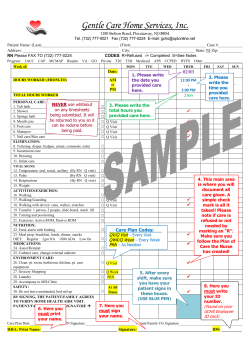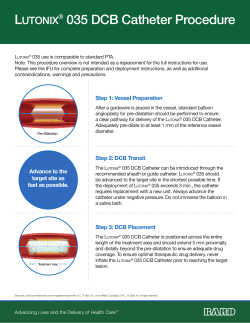
PERIPHERAL VASCULAR CATHETERS Essential Care Standards for Intravascular Devices ™
ORGANISATION WIDE FORM RAH eCENTRAHL SYSTEM OWI-01965 Essential Care Standards for Intravascular Devices PERIPHERAL VASCULAR CATHETERS Insertion • Hand hygiene, wear non sterile gloves, use aseptic technique for insertion. • Skin preparation with chlorhexidine and alcohol ( e.g. Persist Plus™ or Solu-I.V.®) • Cover with highly permeable transparent dressing (Opsite® IV 3000) • Document insertion, intravenous device alert sticker, and insertion site in medical records Maintenance • Hand hygiene before any care • Scrub ports or bungs with alcohol swab and allow to dry before any access • Check insertion site is clean and dressing intact each shift • Document catheter status in medical records each shift. • Communicate catheter status in each patient hand over • Remove catheter - At any signs of extravasation or inflammation - If the catheter is not required - Maximum of 3 days (72 hours) post insertion • Document removal in medical records CENTRAL VENOUS / PICC / DIALYSIS CATHETERS Insertion • Maximum barrier precautions and aseptic technique for insertion Wear hat, mask, hand scrub, sterile gloves, gown and full sterile drape • Skin preparation with chlorhexidine and alcohol (e.g. Persist Plus™ or Solu-I.V.®) • Secure line with fixation device (e.g. Statlock®) • Apply chlorhexidine Biopatch® dressing around insertion sight (blue side up) • Cover with highly permeable transparent dressing (Opsite® IV 3000) • Document insertion in medical records Maintenance • Hand hygiene before any care • Scrub ports or bungs with alcohol swab and allow to dry before any access • Check insertion site is clean and dressing intact each shift • Every 7 days, clean insertion site with chlorhexidine and alcohol, change fixation device, Biopatch®, Opsite® IV 3000 dressing, giving sets, 3 way taps and bungs • Document catheter status in medical records each shift. • Communicate catheter status in each patient hand over • Do not routinely replace catheter and remove as soon as it is not required • Document removal in medical records References• Guidelines for the Prevention of Intravascular Catheter Related Infections 2011 Centre for Disease Control and Prevention (CDC) USA. • Australian Guidelines for the Prevention and Control of Infection in Healthcare 2011. Australian Commission on Safety and Quality in Healthcare. • Royal Adelaide Organisational Wide Instructions on: Intravenous Therapy, Peripherally Inserted Central Catheters, Central Venous Catheters, Haemodialysis Catheters. Version: Originator: Category: 01 Effective Date: October 2011 Peripheral IV Therapy Improvement Group Clinical/Clinical Protocols Last Review: Authorisation: Next Review: Infection Prevention & Control Unit Page No: October 2014 Page 1 of 1
© Copyright 2025





















